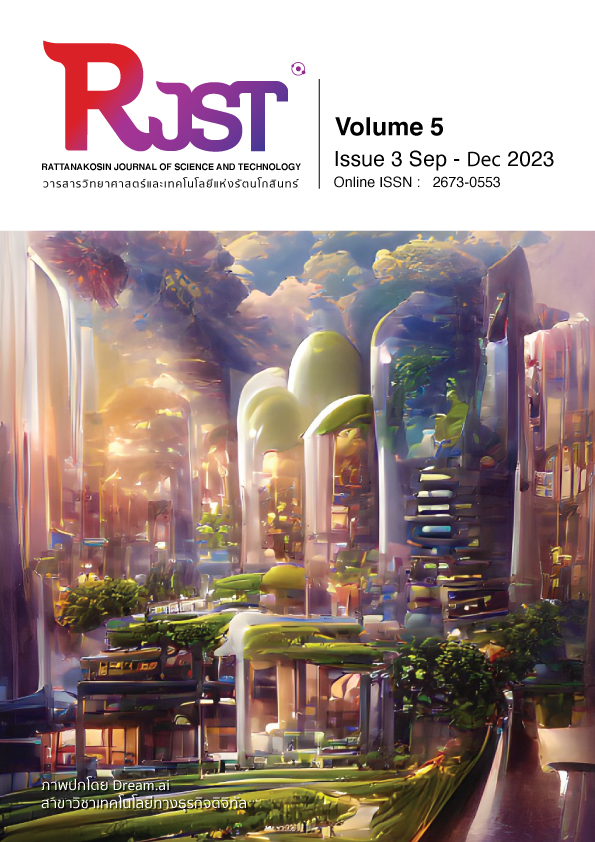Mechanical Properties of Lightweight Concrete Mixed with Palm Ash Reinforced with Palm Bunch Fibers by Steam Curing Method.
Main Article Content
Abstract
This research aims to study of mechanical properties of lightweight concrete. Cement is replaced with palm ash. Percentage 5, 10, 15 and 20. Replace sand with palm fiber. The percentage 0, 2, 4, 6, and 8 percent, respectively. Concrete curing 2 solutions is normal watering and steam curing at ages 3, 7, 14, 21, and 28 days. The study indicated that cement is replaced with palm ash percentage 5 and 10. This results in the highest compressive strength. The method of normal curing and steam curing. Replacement of sand with palm fiber At 2% and 4%. This results in the highest compressive strength. Pulling capacity depends on the increase of palm fiber that replaces sand in increasing ratio. The 8 percent sand replacement ratio results in the highest tensile strength. Comparison of compressive strength development from both curing. Steam curing resulted in an increase in compressive strength of 12 percent. Testing of aerated concrete according to TIS 1505-2541. All ratios are classified in 4 quality classes 0.70 and AAC-WHF. All ratios are classified in 4 quality classes 0.70 and AAC-WHF. Attribute is the material of green building and lightweight concrete type a structure.
Article Details

This work is licensed under a Creative Commons Attribution-NonCommercial-NoDerivatives 4.0 International License.
The content within the published articles, including images and tables, is copyrighted by Rajamangala University of Technology Rattanakosin. Any use of the article's content, text, ideas, images, or tables for commercial purposes in various formats requires permission from the journal's editorial board.
Rajamangala University of Technology Rattanakosin permits the use and dissemination of article files under the condition that proper attribution to the journal is provided and the content is not used for commercial purposes.
The opinions and views expressed in the articles are solely those of the respective authors and are not associated with Rajamangala University of Technology Rattanakosin or other faculty members in the university. The authors bear full responsibility for the content of their articles, including any errors, and are responsible for the content and editorial review. The editorial board is not responsible for the content or views expressed in the articles.
References
Mengyuan Li, Qiang Wang, and Jun Yang. (2017). Advances in Materials Science and Engineering Article ID 9863219, 1-11.
มาลินี ชัยศุภกิจสินธ์ และคณะ. (2540). บทบาทของเส้นใยธรรมชาติต่อสมบัติของแผ่นใยไม้อัดผสม ระหว่างโฟมพอลิสไตรีนกับเส้นใย. วารสารสำนักงานคณะกรรมการวิจัยแห่งชาติ.
ภูษิต เลิศวัฒนารักษ์ และอัญชิสา สันติจิต. (2556). คุณสมบัติของวัสดุไฟเบอร์ซีเมนต์ผสมเส้นใย ธรรมชาติจากเส้นใยมะพร้าวและเส้นใยปาล์มเพื่อผลิตวัสดุก่อสร้าง. บทความวิชาการ Properties of natural cement materials_Anchisa. JAS 9 (1) 2012.
Gritsada Sua-iam and Natt Makul. (2016). Use of palm fiber as a reinforced fiber for improving the bending strength of lightweight foam concrete. Research and Development journal. 29-36.
ธีรพงษ์ จันทร์หอม. (2551). กระบวนการไร่ของเสียในอุตสาหกรรมการสกัดน้ำมันปาล์ม. บทความวิชาการวารสารหาดใหญ่วิชาการ ปีที่ 6 ฉบับที่ 2 กรกฎาคม-ธันวาคม 2551.
Zainab Hashim AbbasHassen Shaker Majdi (2017) Study of heat of hydration of Portland cement used in Iraq Case Studies in Construction Materials. 7, 154-162.
Wenhui Zhao, Qian Su, Feng Han, Wubin Wang (2020) Study on the Heat of Hydration and Strength Development of Cast-In-Situ Foamed Concrete Advances in Materials Science and Engineering Volume 2020, Article ID 9061819, 1-12.
ปริญญา จินดาประเสริฐ และชัยจาตุรพิทักษ์กุล. (2547). ปูนซีเมนต์ ปอซโซลาน และคอนกรีต. กรุงเทพมหานคร: สมาคมคอนกรีตไทย.
ชัย จาตุพิทักษ์กุล. (2547). ปูนซีเมนต์ปอร์ตโซลาน และ คอนกรีต. สมาคมคอนกรีตไทย.
มาตรฐานผลิตภัณฑ์อุตสาหกรรม. (2541). ชิ้นส่วนคอนกรีตมวลเบาแบบมีฟองอากาศ–อบไอน้ำ ประกาศกระทรวงอุตสาหกรรมฉบับที่ 2411 (พ.ศ. 2541) สำนักงานมาตรฐานผลิตภัณฑ์อุตสาหกรรม กระทรวงอุตสาหกรรม (มอก.1505-2541).


